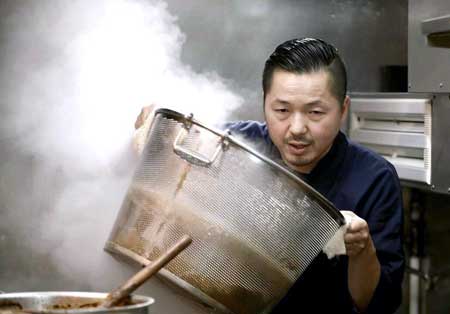Film (2017)
Directed by Koki Shigeno
Kendall Square Cinema
Cambridge, MA

in “Ramen Heads”
Image: Courtesy of Gunpowder and Sky
In many ways, Ramen is a humble dish: broth with noodles, sometimes enhanced by a slab of meat. And yet, as this very fun and informative film demonstrates, there is a fine art to its production.
The film’s hero is Osamu Tomita, a Ramen master in Matsudo, Chiba, a prefecture (county) right near Tokyo. Tomita’s reputation reaches so far that it is not infrequently the case that lines stretch for hours in front of his small shop.
The first part of the film details Tomita method, which is involved and extraordinary. As one watches him with utter concentration mixing three different brews to create the exactly desired consistency and taste, one realizes indeed how much of an art goes into the creation of the broth which provides the foundation for the Ramen concoction.
Tomita runs his operation, as well, like a Zen temple. Apprentices abound, and he insists that they remain ever vigilant and on their game. If they don’t, he sends them out into the parking lot to reconstitute themselves.
We also see, remarkably, what Tomita puts into his brew. It’s literally amazing to watch as the constituents get added – whole bulbs of garlic, entire onions with the skin, a pig’s head, and plenty more. There are no secrets to Tomita’s recipe, which is also astounding, considering that he has been voted the best Ramen chef in Japan for several years running.
It’s sweet to hear him talk about what some might consider to be a humble art. “I like that we can create an amazing experience for $8,” he says. And it does truly seem that the experience is amazing. Serving up between 800-1000 bowls of Ramen a day, Tomita’s enterprise thrives on what seems to be the endless appetite of the public for his artful creation.
We also watch Tomita on his day off, equally astoundingly, taken up by visits to several of his favorite Ramen shops. Though to an untutored sensibility, all Ramen may seem the same, this film does a great job of demonstrating the distinctions between styles. One place produces a very simple broth out of Red Snapper alone. Another uses a couple of types of Miso, another from dried sardines, each unique in its own way.
It is charming to see that Tomita does not want the filmmaker to reveal the name of his favorite Ramen shop (not his own!) that he frequents on his day off.
Tomita’s family is shown at home and there is an adorable moment in which the filmmaker interviews his older son who pledges utter commitment to the Ramen dynasty. With a sweet fidelity seemingly advanced for a boy not yet a teenager, he demonstrates a faithful allegiance to the art that his father has cultivated so earnestly.
The film has a hilarious soundtrack, filled with the likes of Dvorak’s Humoresque, to accompany the various Ramen shop scenes. It’s varied and stimulating, showing a good amount of irony about its humble, but magnificently executed, subject-matter.
Like the celebrated Jiro Dreams of Sushi (2011), this is a great film about Japanese cuisine and deserves to be seen by foodies, Japan-lovers, and anyone who appreciates the cultivation of seriousness about art in any its many wonderful forms.
– BADMan
Leave a Reply